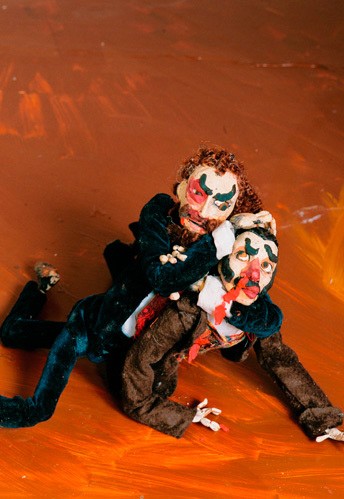
Nathalie Djurberg, Rallarfighten, 2005 © Nathalie Djurberg
The 1st at Moderna: Nathalie Djurberg
1.8 2005 – 23.10 2005
Stockholm
The form is reminiscent of children’s TV programmes and seeing her films undeniably feels like being a child again. The world is big and there are exciting new things in it.
We soon understand, however, that those exciting new things have a dark, menacing side. Girls playing among dazzling flowers suddenly start fighting, a man who jokes increasingly brazenly with two girls is brutally knocked to the ground, and in another film two girls are drowned in excrement. Animals appear, too, not always as cuddly pets, but also as untamed or cunning beasts. Even the inserted speech bubbles contain crude and at times misspelt words. It is as though Djurberg brings out aspects of humanity and its surroundings that we do not want to acknowledge.
Nathalie Djurberg was born in 1978 in Lysekil, Sweden, and was only nineteen when she got into Malmö Art Academy. At that time, she worked primarily with painting, but gradually began to experiment with Super 8 film. She, for instance, made a film of a painting with a sun rising and setting. When she then discovered the possibilities of plasticine, the films began to grow into small narratives. She did a bit of filming in one corner of her studio, not thinking at the time that it was proper art. It was only when an external tutor commented that the films did not fit in anywhere other than in art, that she got the courage to exhibit them.
I would describe her works as children’s films for adults only. The idyll of the world of fairytale is ripped apart by intense brutality and angst. Her work deals with solitude and humanity’s occasionally absurd behaviour. But also with war, fear, insecurity and sexuality. I suspect there is a great deal of Djurberg herself in the films. Perhaps she is working out her own despair and her own fears? And maybe she occasionally lives out a few secret fantasies?
The almost psychotic film music by Hans Berg reinforces the feeling of something bordering on collapse. It bleeps and bloops in a mixture of twiddly bits from ice-cream vans and digitised funfair music. Taken as a whole, it is as though the narratives and the music together become a metaphor for a social or in fact societal situation. To an increasing extent, in more and more media, we are bombarded with sex and violence in every possible and impossible variant. Everything is up for sale. It is difficult to defend oneself, to protect one’s own life in such circumstances.
Djurberg employs a sardonic humour in her films to create a distance from their serious subject matter. I smile, giggle and laugh despite the often violent events in the narrative. The abrupt shifts between laughter and despair create a link with Sigmund Freud – humour becomes a form of disobedience, a refusal to submit to social prejudice. Or as Yvonne Duplessis writes in Le surréalisme (1950): “Humour is not only the hallmark of those who do not allow themselves to be blinded by reality. It also has a more profound aspect, to the extent that it expresses the self’s will to liberate itself from reality and to become immune to its attacks. The shocks of the external world can even give rise to pleasure. André Breton quotes Freud’s example, in which a condemned man calls out on his way to the gallows one Monday: ‘The week is beginning well!’ Thanks to the way humour spares us ‘the test that pain forces on us’, it has a ‘higher value’, and ‘we see it as especially effective for liberating and elevating ourselves’.”
Breton’s interpretation of humour as being “for liberating and elevating ourselves” was an important component in surrealism’s view of art’s utopian potential for creating a better, more beautiful world. The surrealists wanted to change the world by making visible the ‘true’ reality of the unconscious: an absolute truth, beyond the false façade of bourgeois reason.
In her own way Djurberg also sneaks into our unconscious. I do not, however, believe that her artistic vision is about “liberating and elevating ourselves”. Yet, she does want us to see through the falsehood and mendacity. Specifically the world of fairytale is an effective tool here, since it occasionally strengthens prejudices rather than demolishing them. But, at the same time, she uses the freedom of the fairytale world to make up stories and to tell tales about complex human behaviours. The films criticise bullying in all its forms and it is always the beaten or abused who win in the end. The humour inspires both hope and despair, but above all it is an attitude that does not let us get caught, ring-marked or controlled. Just what Nathalie Djurberg does.
Curator: John Peter Nilsson
The 1st at Moderna is an exhibition programme for contemporary art. The opening is always on the first day of the month, and the exhibitions are in different venues in or outside the museum.
